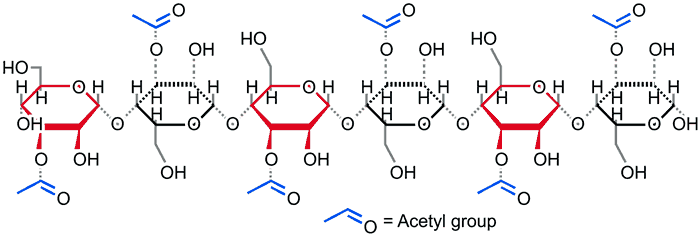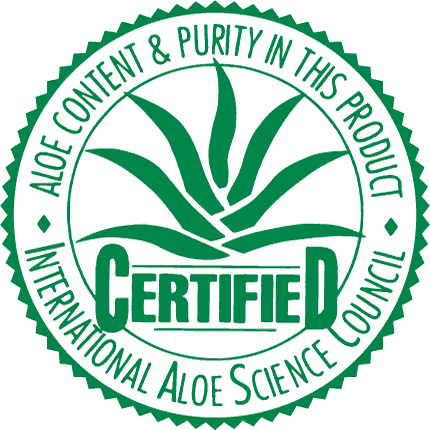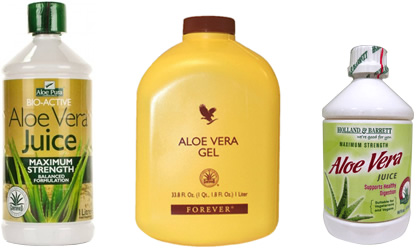With some extraordinary claims being made about the health benefits of aloe vera gel, I decided to try and understand the plant’s inner properties. How could one plant be able to treat a diverse range of ailments, from skin complaints to digestive problems, and problems concerning the human immune system?
Aloe-Polysaccharides
The inner gel and the inner part of the rind (outer leaf) of the Aloe Vera plant contain something called Aloe-Polysaccharides. A Polysaccharide is a Polymer, which is a large molecule consisting of smaller sub-units (in this case Monosaccharides) that are joined together in a chain.

The chemical composition of Acemannan (Aloe-Polysaccharides)
The Aloe-Polysaccharides are unique to the Aloe Vera plant. They are not found in any other plant in the Aloe family. According to the IASC (International Aloe Science council) they are also known as Acemannan or Aloeverose [1]. According to Dr Ivan Danhof (US) and Dr Peter Atherton (UK), it is primarily this substance (among others) that gives Aloe Vera it’s medicinal power.
Most Aloe Vera drinks (or juices) should contain a good amount of Aloe-Polysaccharides, as the product should essentially contain the raw material with minimal heat treatment or chemical interference. The Aloe-Polysaccharides are found in both the inner gel deep inside the Aloe leaves and within the inner part of the outer green rind.
When I first discovered the Aloe Vera super-ingredient, I assumed that the higher the concentration in an Aloe Vera juice drink, the better it would be. However, I learnt that an Aloe Vera juice drink does not have to contain a high concentration of Aloe-Polysaccharides to provide maximum benefit.
According to Dr Peter Atherton there only needs to be about 1200-1400 mg per litre in a product to get maximum absorption, and this is because there are only a limited number of specialised cells lining the small bowel capable of absorbing this long chain sugar whole, without the need for it to be broken down by enzymatic action. So therefore, any extra polysaccharide in the product over and above the absorption capacity of these cells is wasted [2].
Aloin
Despite the fact that Aloe-Polysaccharides are found throughout most of the Aloe Vera leaves, the rind of the plant also contains a yellowish green latex-like sap which contains a chemical called Aloin.
Laboratory experiments on rats in the US have also proven Aloin to be carcinogenic, which means it can cause cancer. I know what you’re probably thinking. When I first learnt about this I though ‘Yikes!’. I certainly don’t like the idea of ingesting anything with any carcinogenic properties. However, my fears were to be allayed.
Aloin functions as a laxative, and products containing Aloin were being sold in the US for this purpose. However, in 2002 the US Food and Drug Administration issued a ruling preventing products containing Aloin from being sold over-the-counter in drug stores in the United States [2,3].
Fortunately, the amount of Aloin contained in Aloe Vera drinks is incredibly small. In fact, I would say virtually 0%, as many manufacturers use patented filtration processes to remove the Aloin from their Aloe. Roy Upton (executive director of the American Herbal Pharmacopeia) noted that the lab experiments involved the use of very high-yielding Aloin products, in which some of them averaged 6,300 ppm (parts per million). A good quality Aloe Vera juice product only contains about 5 ppm [4].
As for the tiny quantity of Aloin found in the juices, this does provide some health benefits. It helps strengthen muscle in the intestine and reduces transit time. It also has analgesic (pain-killing), anti-bacterial, anti-fungal and anti-viral properties [5].
The regulators
After reading about the wonder ingredient ‘Aloe-Polysaccharides’ and the ingredient that initially alarmed me ‘Aloin’, I wanted to find out if there was some type of regulatory body ensuring that the Aloe Vera juice products contained sufficiently high quantity Aloe Vera. After researching various products, I found that a small number used a seal of approval granted by the IASC (International Aloe Science Council).
The job of the IASC is to ensure that Aloe Vera products for oral consumption contain raw Aloe materials with a sufficiently high percentage of actual Aloe Vera. Also, that ingestible products consisted of a sufficiently high level of Aloe-Polysaccharides, and low amounts of Aloin – no more than 10 parts per million to be precise. The IASC operates independently without any association with product manufacturers, and only awards it’s seal of approval to products that it has tested and found to be up to it’s high standard.
Product viability
There are a vast number of drinks containing Aloe Vera sold all round the world. Unfortunately, some contain very little Aloe Vera yet are marketed as Aloe drinks. Some products might contain of larger amounts of Aloe Vera, yet the quantities of Aloin may be too high, and quantities of Aloe-Polysaccharides may not be sufficiently high to yield the health benefits that the Aloe Vera plant is known for.
During my research I contacted various manufacturers to better understand the ingredients of their products, and also to find out where their Aloe Vera came from. Some were able to provide quite detailed information, yet others were not able to provide the origin of their Aloe, nor the Aloe-Polysaccharide and Aloin content.
I also found that no Aloe Vera juice contained 100% Aloe Vera. If this were the case, the products would contain no preservative (natural or unnatural) and wouldn’t be able to be shipped to their destination and stored before starting to go off. It seems that nearly all of the main products contain just over 97% Aloe Vera.
The most useful way to understand the quality of an Aloe Vera juice product is by checking the percentage of Aloe Vera within the product, which should ideally be no less than 97%. The other thing to look for, which is probably the most important indicator of quality, is to check whether the product carries an IASC Seal of Approval. However, as a word of warning, I found that some products carried the IASC seal on their packaging, but when I checked the IASC website, I found that the product was listed as “no longer approved”, so it seems that some products carry the seal without authorization.
Inner Fillet Gel vs Whole Leaf
Another difference between the various products, is that some consist of ‘inner fillet gel’ which means that only the gel within the Aloe Vera leaf is used, and the outer leaf is discarded – most likely as a means to eliminate as much of the Aloin as possible without the need for greater filtering and processing to remove the less desirable chemical.

Other products are classified as ‘whole leaf’. These juices are made from both the inner gel and the outer leaf. The purpose of this is to extract the highest concentration of Aloe-Polysaccharides, as they are to be found in greater abundance where the inner gel meets the outer leaf. The trouble with the Aloe leaf is it contains the Aloin, so greater filtration processes like ‘charcoal filtering’ must be used to ensure that the latexy material containing the Aloin is removed. There are some ‘whole leaf’ products that have met the IASC Seal of approval, which would indicate that the Aloin has been successfully removed. However, charcoal filtering may also remove much of the Aloe-Polysaccharides.
Product comparison
Below is an example of three Aloe Vera juice products sold in the UK. The “Forever Living: Aloe Vera Juice” is also available internationally:
| Product | Aloe Vera | Aloe-Polysaccharides | Life after opening | IASC Certified ** |
|---|---|---|---|---|
| Forever Living Gel | Over 97% | 4,490 mg/L * | 3 months | |
| Aloe Pura Juice | Over 97% | No data supplied | 2 months | |
| Holland & Barrett Juice | Over 97% | No data supplied | 1 month |
* Testing carried out by Deibel Laboratories, Madsion, WI (2013)
** IASC (25th September 2013)
Unfortunately, exact figures of Aloe-Polysaccharide content are rarely available on Aloe Juice packaging, and some of the manufacturers I spoke to, were only able to give me data from what they claim are their most recent tests. My research has indicated that it is very unlikely that levels of Aloe-Polysaccharide will remain constant from batch to batch, as the Aloe is a natural harvested product, and unlike less natural products, is not created in a very precise and machine-like processes.
Aloe Pura
Forever Living
Holland & Barrett
Therefore it seems that certification from the IASC, serves as the best guide for identifying products with suitable levels.
I recommend drinking Aloe Vera juice for it’s various health benefits, that other natural products seem to lack. According to Dr Peter Atherton it is best to drink it first thing in the morning. When choosing an Aloe Vera Juice, I strongly recommend products with IASC certification.
Thank you for reading, and I really would appreciate giving me your comments below
![]()
Toby Barnes
Source
- 1. Devon Powell, Executive Director of IASC (email communication)
- 2. FDA docket Sec. 310.545 (a)(12)(iv)(c) (fda.gov/ohrms/dockets/98fr/050902a.htm)
- 3. NCCAM Publication No.: D333 (nccam.nih.gov/health/aloevera)
- 4. American Herbal Pharmacopoeia® (AHP): Press Release, 18 Dec 2012 (herbal-ahp.org)
- 5. Barcroft, A. Myskja, A. Reynolds, T. 2003, Aloe Vera: Nature’s Silent Healer, pp46
Post: inside-aloe-vera-gel | Version 1.9



